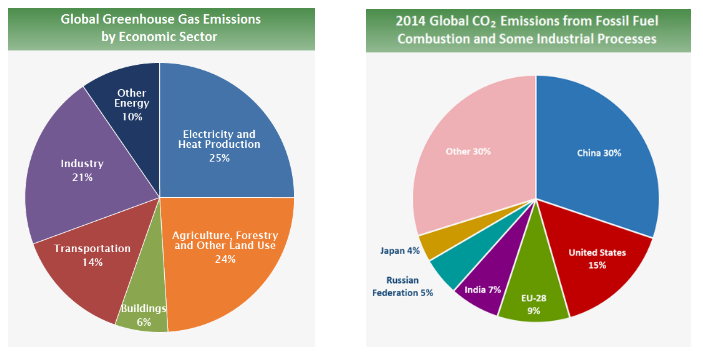Dear Reader,
Later this month, at COP 28 in Dubai, delegates from nearly every country on Earth will gather to negotiate global goals for tackling climate change, present their individual countries’ plans for contributing to those goals, and report on their progress. There can be no better time to shine the spotlight on one of the most controversial yet crucial technologies to mitigate climate change, Carbon Capture.
We also take this opportunity to wish an Electrifying Diwali to all those celebrating!
Now, let’s dive right in!
The urgency to address climate change, underscored by the Intergovernmental Panel on Climate Change (IPCC), emphasizes the need not only to reduce emissions but also to actively deploy technologies capable of removing carbon from the atmosphere. In this context, Carbon Capture, Utilization, and Storage (CCUS) becomes a crucial technology in our collective pursuit of limiting global temperature increases to 1.5°C (2.7°F), as outlined in the Paris Agreement.
Source: International Energy Agency
Industries and Countries with Significant CO2 Emissions

Methods of Carbon Capture
Carbon capture technology has been deployed at several industrial projects since the 1970s but its application to power generation is relatively recent.
For industrial processes and electricity generation, current systems must be redesigned to capture and concentrate carbon dioxide, usually using one of these methods:
- Pre-Combustion Carbon Capture: Gasifies fuel to produce a mixture of CO and H2, then separates the CO2 using a physical solvent. This method can be used with integrated gasification combined cycle (IGCC) power plants.
- Post-Combustion Carbon Capture: Post-combustion capture uses chemical solvents to separate CO2 from the flue gas from fossil fuel combustion. This method will likely be used to retrofit existing power plants for carbon capture.
- Oxyfuel Carbon Capture: Oxyfuel capture requires fossil fuel combustion in pure oxygen which facilitates capture.
Source: C2ES, netl, Fossil Transition
CO2 Utilization Pathways
CO2 utilization technologies have the potential to play a significant role in reducing greenhouse gas emissions. These technologies can convert CO2 into a variety of useful products, such as fuels, chemicals, and building materials.
CO2 Chemicals: Utilizing CO2 to produce chemicals could remove 0.3 to 0.6 gigatonnes of CO2 per year from the atmosphere in 2050. This process could even be profitable, with costs ranging from -$80 to $300 per tonne of CO2.
CO2 Fuels: Combining CO2 with hydrogen to produce fuels could address a huge market, but the costs are currently high. CO2 fuels could utilize 1 to 4.2 gigatonnes of CO2 per year in 2050, but costs could be up to $670 per tonne of CO2.
Microalgae: Microalgae can be used to fix CO2 and produce fuels and chemicals. This technology is still in the early stages of development, but it has the potential to utilize 0.2 to 0.9 gigatonnes of CO2 per year in 2050.
Concrete Building Materials: CO2 can be used to cure cement and manufacture aggregates. This technology could store a significant amount of CO2 for the long term and displace emissions-intensive conventional cement. CO2 concrete could utilize and store 0.1 to 1.4 gigatonnes of CO2 in 2050, with costs ranging from -$30 to $70 per tonne of CO2.
CO2-Enhanced Oil Recovery (EOR): Injecting CO2 into oil wells can increase the production of oil. If done correctly, this process can store more CO2 than is produced on consumption of the final oil product. CO2 EOR could utilize and store 0.1 to 1.8 gigatonnes of CO2 per year in 2050, at costs that are between -$60 and -$40 per tonne of CO2.
Bioenergy with Carbon Capture and Storage (BECCS): BECCS involves growing trees to capture CO2, producing electricity through bioenergy, and sequestering the resulting emissions. This technology could utilize and store 0.5 to 5 gigatonnes of CO2 per year in 2050.
Enhanced Weathering: Crushing rocks such as basalt and spreading them on land can accelerate the formation of carbonate from atmospheric CO2. This technology is still in the very early stages of development, but it has the potential to store a significant amount of CO2 in the long term.
Forestry: Timber from new and existing forests can be used to store CO2 in buildings and displace cement use. Forestry could utilize up to 1.5 gigatonnes of CO2 in 2050, at costs of between -$40 and $10 per tonne of CO2.
Soil Carbon Sequestration: Land management techniques for soil carbon sequestration can store CO2 in the soil and enhance agricultural yields. Soil carbon sequestration could utilize 0.9 to 1.9 gigatonnes of CO2 per year in 2050.
Biochar: Biochar is produced by burning plant material at high temperatures under low oxygen levels. Biochar application to agricultural soils can increase crop yields and store CO2 in the soil. Biochar could utilize 0.2 to 1 gigatonnes of CO2 per year in 2050.
Source: Energy Post EU
Tracking of Carbon emissions
All ten CO2 utilization pathways offer economic motivation, together with some degree of climate mitigation potential. CO2 utilization can help in two main ways: the removal and long-term storage of atmospheric CO2; and the reduction of CO2 emissions to the atmosphere. Potentially, using CO2 to make valuable products might also offset some of the costs of climate change mitigation.
Global carbon dioxide (CO2) emissions from energy combustion and industrial processes grew 0.9% or 321 Mt in 2022 to a new all-time high of 36.8 Gt.
Source: IEA Report 2022, Energy Post EU
Where is CCS being used already?
According to the Global CCS Institute’s 2022 report, there were 194 large-scale CCS facilities globally in 2022, compared to 51 in 2019.
The CO2 capture capacity of all CCS facilities under development grew to 244 million tonnes per annum in 2022, an impressive increase of 44% over the year.
Source: National Grid
How India is looking at Carbon Capture?
At COP26, India announced its ambition to become a net-zero emitter by 2070—an important milestone in the fight against climate change. Despite low per-capita emissions (1.8 tons CO2), India is the third-largest emitter globally, emitting a net 2.9 gigatons of carbon dioxide equivalent (GtCO2e) every year as of 2019. The bulk of these emissions (about 70%) are driven by six sectors: power, steel, automotive, aviation, cement, and agriculture.
The Indian government is taking a leading role in the development and deployment of carbon capture, utilization, and storage (CCUS) technologies, which are essential for achieving global decarbonization goals. The government is establishing two National Centres of Excellence in Carbon Capture and Utilisation, participating in the Mission Innovation Challenge on CCUS, collaborating with the Department of Biotechnology on CO2 storage research, and joining forces with 11 other countries to accelerate CCUS innovation and deployment.
Source: Mckinsey, Sunday Guardian.
Pros and cons of CCUS
Carbon capture, utilization, and storage (CCUS) is a promising approach to reducing greenhouse gas emissions by capturing, re-using, and storing carbon dioxide from industrial processes and power plants.
CCUS offers adaptability, allowing retrofits to existing power and industrial plants, ensuring their continued operation. This technology proves particularly effective in hard-to-abate sectors, including significant industries like cement, steel, and chemicals. Furthermore, CCUS emerges as a critical enabler for the least-cost low-carbon hydrogen production, supporting broader decarbonization efforts across industries, trucks, ships, and various energy systems.
It offers economic, social, and environmental benefits like job creation and reduced air pollution.
However, challenges include high costs, energy-intensive processes, and environmental risks. While policymakers and industry leaders continue to explore the potential of CCS, it is important to consider these pros and cons and weigh the benefits against the costs. Ultimately, the success of CCS will depend not only on its technical feasibility but also on its economic viability and social acceptance.
Source: Verde Blog, Treehugger
Do write to us with topics in Climate-tech, Mobility, and New Energy that you’d like us to cover in future editions.
















